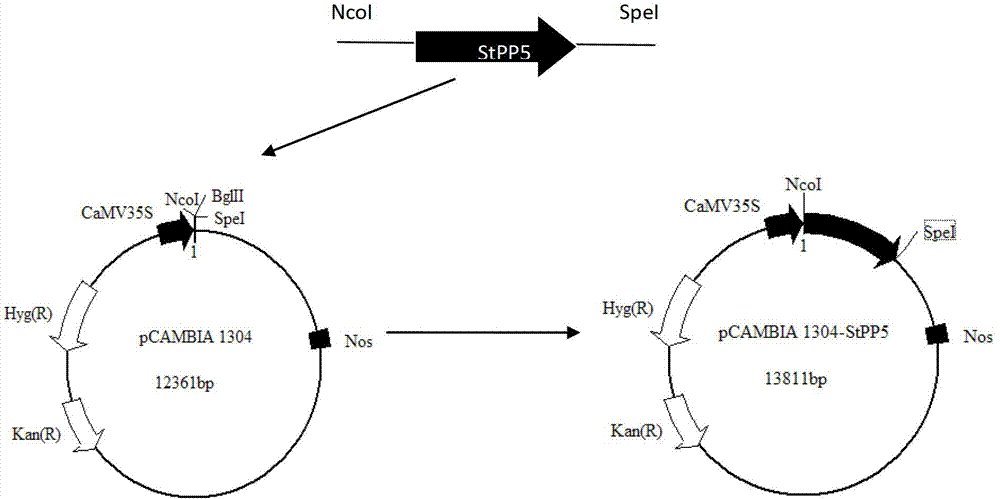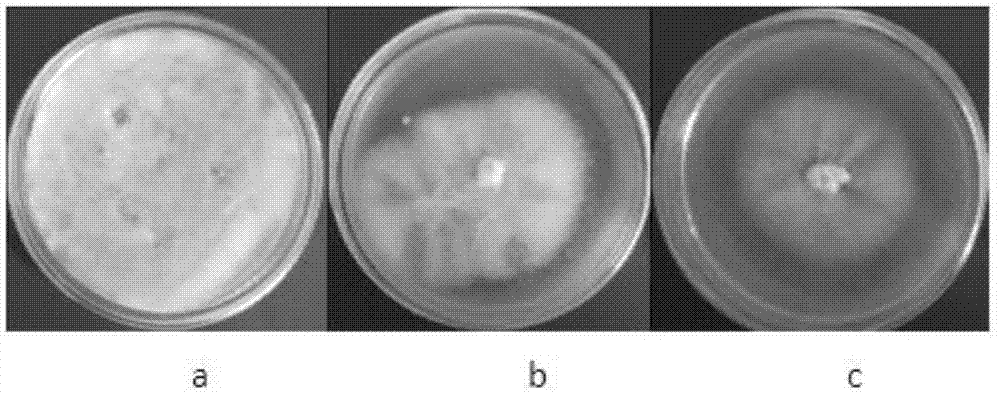Application of wild eggplant 5 type serine/threonine protein phosphatase gene StPP5
A gene and protein technology is applied in the application field of wild eggplant type 5 serine/threonine protein phosphatase gene StPP5, which can solve the problems of economic crops prone to verticillium wilt disease, economic loss, crop yield and quality decline, etc.
- Summary
- Abstract
- Description
- Claims
- Application Information
AI Technical Summary
Problems solved by technology
Method used
Image
Examples
Embodiment 1
[0019] Example 1 Cloning of StPP5 Gene in Wild Eggplant Torubum
[0020] Primers were designed according to the conserved segment sequences of PP5 genes in potato, tobacco, tomato, and sweet pepper in GenBank, and amplified respectively. RT-PCR was carried out using the first strand of cDNA from young leaves of wild eggplant as a template. The middle fragment with a length of about 800bp was obtained by sequencing. According to the obtained middle fragment sequence, different gene-specific primers were designed to amplify the two ends of wild eggplant PP5 gene cDNA. The amplified end sequences were about 1100bp and 1150bp in size, respectively, and the overlapping region with the middle conservative segment could be found in the sequencing results of the two amplified products, which indicated that the obtained fragments were both end sequences of the same gene. The sequences of the three fragments were spliced, primers were designed according to the spliced sequences, and ...
Embodiment 2
[0035] Example 2 Increased expression of StPP5 gene under stress induction
[0036] The salicylic acid (SA) chemical reagent was used to induce up-regulation of its expression, and the healthy and disease-free 9-10 leaf stage seedlings were taken for chemical treatment as follows: the salicylic acid was dissolved in water to make the final concentration 50mM, and the control treatment was Tween20 / water to make it similar to corresponding chemical treatment conditions. The leaves of all plants were sampled at 0h, 12h, 24h, 48h, and 72h after treatment, and all were frozen and stored in a -70°C refrigerator. RNA was extracted for semi-quantitative reverse transcription PCR (RT-PCR) analysis. The internal reference was the constitutively expressed GAPDH gene, and the primers were GAPDH1: 5′-CAAGGACTGGAGAGGTGG-3′ (SEQ ID NO.7) and GAPDH2: 5′ - TTCACTCGTTGTCG TAC-3' (SEQ ID NO. 8). The PCR conditions were: 94°C pre-denaturation for 5 minutes, then 94°C for 40s; 53°C for 40s; 72°C...
Embodiment 3
[0039] Example 3 Construction of Wild Eggplant Torubum StPP5 Gene Overexpression Vector
[0040] According to the homologous sequence as a template, primers were designed, and the full-length enzyme cleavage site was cloned. The recovered product was ligated with PMD18-T Vector, transformed into Escherichia coli for amplification, and the plasmid was extracted for double enzyme digestion. Recover and purify to obtain the target fragment with enzyme cleavage site, connect the target gene fragment with the large fragment of pCAMBIA1304 vector recovered after corresponding double enzyme digestion, transform into Escherichia coli DH5α, pick positive single clone colony by PCR and shake Bacteria and plasmid extraction, sequencing. Sequencing results showed that the target gene had been successfully inserted into the pCAMBIA1304 vector. Specific steps are as follows:
[0041] Add Nco Ⅰ and Spe Ⅰ restriction sites to the forward and reverse ends of the cDNA of the StPP5 gene fragm...
PUM
| Property | Measurement | Unit |
|---|---|---|
| Diameter | aaaaa | aaaaa |
| Diameter | aaaaa | aaaaa |
| Molecular weight | aaaaa | aaaaa |
Abstract
Description
Claims
Application Information
 Login to View More
Login to View More - R&D
- Intellectual Property
- Life Sciences
- Materials
- Tech Scout
- Unparalleled Data Quality
- Higher Quality Content
- 60% Fewer Hallucinations
Browse by: Latest US Patents, China's latest patents, Technical Efficacy Thesaurus, Application Domain, Technology Topic, Popular Technical Reports.
© 2025 PatSnap. All rights reserved.Legal|Privacy policy|Modern Slavery Act Transparency Statement|Sitemap|About US| Contact US: help@patsnap.com



